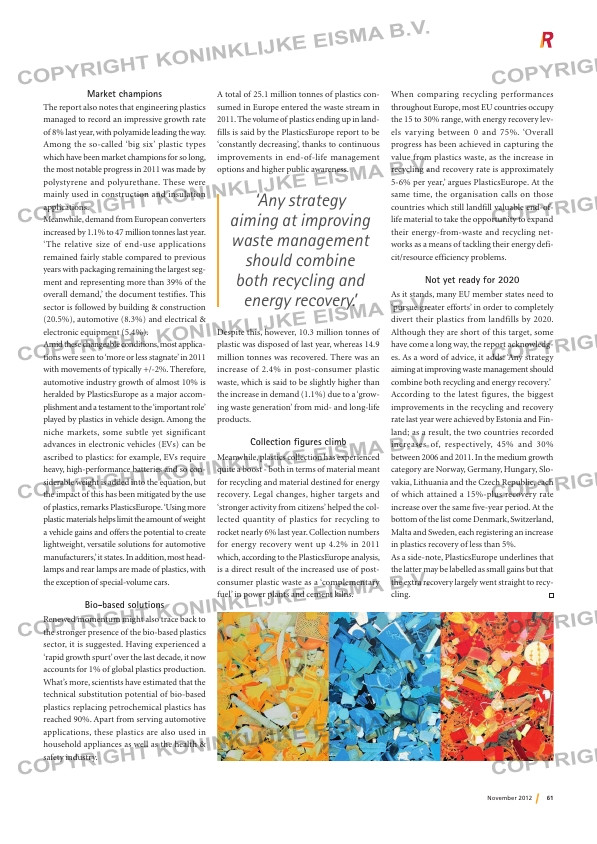Page 61 from: November 2012

61November 2012
Market champions
The report also notes that engineering plastics
managed to record an impressive growth rate
of 8% last year, with polyamide leading the way.
Among the so-called ‘big six’ plastic types
which have been market champions for so long,
the most notable progress in 2011 was made by
polystyrene and polyurethane. These were
mainly used in construction and insulation
applications.
Meanwhile, demand from European converters
increased by 1.1% to 47 million tonnes last year.
‘The relative size of end-use applications
remained fairly stable compared to previous
years with packaging remaining the largest seg-
ment and representing more than 39% of the
overall demand,’ the document testifies. This
sector is followed by building & construction
(20.5%), automotive (8.3%) and electrical &
electronic equipment (5.4%).
Amid these changeable conditions, most applica-
tions were seen to ‘more or less stagnate’ in 2011
with movements of typically +/-2%. Therefore,
automotive industry growth of almost 10% is
heralded by PlasticsEurope as a major accom-
plishment and a testament to the ‘important role’
played by plastics in vehicle design. Among the
niche markets, some subtle yet significant
advances in electronic vehicles (EVs) can be
ascribed to plastics: for example, EVs require
heavy, high-performance batteries and so con-
siderable weight is added into the equation, but
the impact of this has been mitigated by the use
of plastics, remarks PlasticsEurope. ‘Using more
plastic materials helps limit the amount of weight
a vehicle gains and offers the potential to create
lightweight, versatile solutions for automotive
manufacturers,’ it states. In addition, most head-
lamps and rear lamps are made of plastics, with
the exception of special-volume cars.
Bio-based solutions
Renewed momentum might also trace back to
the stronger presence of the bio-based plastics
sector, it is suggested. Having experienced a
‘rapid growth spurt’ over the last decade, it now
accounts for 1% of global plastics production.
What’s more, scientists have estimated that the
technical substitution potential of bio-based
plastics replacing petrochemical plastics has
reached 90%. Apart from serving automotive
applications, these plastics are also used in
household appliances as well as the health &
safety industry.
A total of 25.1 million tonnes of plastics con-
sumed in Europe entered the waste stream in
2011. The volume of plastics ending up in land-
fills is said by the PlasticsEurope report to be
‘constantly decreasing’, thanks to continuous
improvements in end-of-life management
options and higher public awareness.
Despite this, however, 10.3 million tonnes of
plastic was disposed of last year, whereas 14.9
million tonnes was recovered. There was an
increase of 2.4% in post-consumer plastic
waste, which is said to be slightly higher than
the increase in demand (1.1%) due to a ‘grow-
ing waste generation’ from mid- and long-life
products.
Collection figures climb
Meanwhile, plastics collection has experienced
quite a boost – both in terms of material meant
for recycling and material destined for energy
recovery. Legal changes, higher targets and
‘stronger activity from citizens’ helped the col-
lected quantity of plastics for recycling to
rocket nearly 6% last year. Collection numbers
for energy recovery went up 4.2% in 2011
which, according to the PlasticsEurope analysis,
is a direct result of the increased use of post-
consumer plastic waste as a ‘complementary
fuel’ in power plants and cement kilns.
When comparing recycling performances
throughout Europe, most EU countries occupy
the 15 to 30% range, with energy recovery lev-
els varying between 0 and 75%. ‘Overall
progress has been achieved in capturing the
value from plastics waste, as the increase in
recycling and recovery rate is approximately
5-6% per year,’ argues PlasticsEurope. At the
same time, the organisation calls on those
countries which still landfill valuable end-of-
life material to take the opportunity to expand
their energy-from-waste and recycling net-
works as a means of tackling their energy defi-
cit/resource efficiency problems.
Not yet ready for 2020
As it stands, many EU member states need to
‘pursue greater efforts’ in order to completely
divert their plastics from landfills by 2020.
Although they are short of this target, some
have come a long way, the report acknowledg-
es. As a word of advice, it adds: ‘Any strategy
aiming at improving waste management should
combine both recycling and energy recovery.’
According to the latest figures, the biggest
improvements in the recycling and recovery
rate last year were achieved by Estonia and Fin-
land; as a result, the two countries recorded
increases of, respectively, 45% and 30%
between 2006 and 2011. In the medium growth
category are Norway, Germany, Hungary, Slo-
vakia, Lithuania and the Czech Republic, each
of which attained a 15%-plus recovery rate
increase over the same five-year period. At the
bottom of the list come Denmark, Switzerland,
Malta and Sweden, each registering an increase
in plastics recovery of less than 5%.
As a side-note, PlasticsEurope underlines that
the latter may be labelled as small gains but that
the extra recovery largely went straight to recy-
cling.
‘Any strategy
aiming at improving
waste management
should combine
both recycling and
energy recovery.’
RI_9-Plastic Facts.indd 61 09-11-12 13:04



